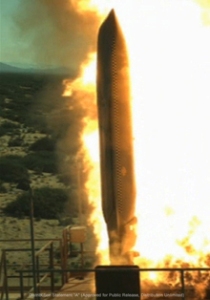Lockheed Martin successfully launched the first Long Range Anti-Ship Missile (LRASM) Boosted Test Vehicle (BTV) from a MK 41 Vertical Launch System (VLS) canister at White Sands Missile Range, N.M.
 LRASM
LRASM
During the company-funded test, the MK41 VLS successfully launched the LRASM BTV. The BTV, which includes the proven Vertical Launch Anti-Submarine Rocket (VL/ASROC) Mk-114 rocket motor, ignited successfully, penetrated and exited through the canister cover and performed a guided flight profile similar to a tactical configuration.
The flight test was part of an ongoing Lockheed Martin-funded Offensive Anti-Surface Weapon effort, independent of the Defense Advanced Research Project Agency (DARPA) LRASM program, focused on shipboard integration of LRASM’s surface launched variant.
Building on the recent push-through testing which proved the missile’s ability to break through the canister cover with no damage to the missile, the BTV launch is also an important risk reduction milestone critical to demonstrating LRASM’s surface launch capability.
LRASM is an autonomous, precision-guided anti-ship standoff missile leveraging the successful Joint Air-to-Surface Standoff Missile Extended Range (JASSM-ER) heritage, and is designed to meet the needs of U.S. Navy and Air Force warfighters.
“This successful flight test reduces the risk of LRASM and VLS integration,” said Scott Callaway, LRASM surface launch program manager at Lockheed Martin Missiles and Fire Control. “The test also validates the Mk-114 rocket motor’s capability to launch LRASM and the missile’s ability to cleanly exit the canister without damaging the missile coatings or composite structure.”
The BTV flight was the first time a Mk-114 rocket motor was used to launch LRASM. The Mk-114 rocket motor is currently deployed as the rocket motor for the VL/ASROC, so this flight test verified that the Mk-114’s robust design can be used for heavy payloads with minimal software changes to the Digital Autopilot Controller.
Armed with a proven penetrator and blast-fragmentation warhead, LRASM cruises autonomously, day or night, in all weather conditions. The missile employs a multi-modal sensor, weapon data link and an enhanced digital anti-jam Global Positioning System to detect and destroy specific targets within a group of ships.
LRASM is in development with DARPA and the Office of Naval Research. Lockheed Martin’s offering has both surface launched and air launched variants to prosecute sea-based targets at significant standoff ranges.
Lockheed Martin Missiles and Fire Control is a 2012 recipient of the U.S. Department of Commerce’s Malcolm Baldrige National Quality Award for performance excellence. The Malcolm Baldrige Award represents the highest honor that can be awarded to American companies for achievement in leadership, strategic planning, customer relations, measurement, analysis, workforce excellence, operations and business results.